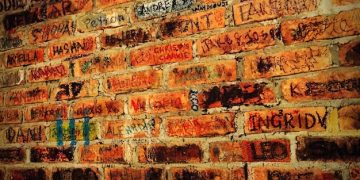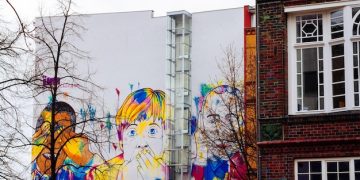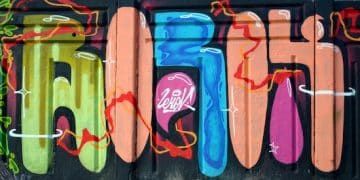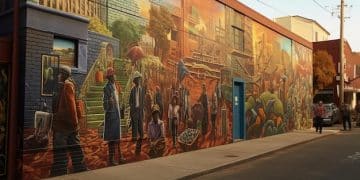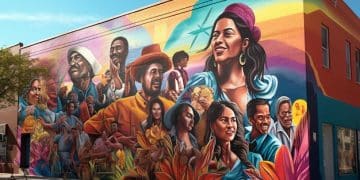Ethical Considerations for US Graffiti Artists in 2025
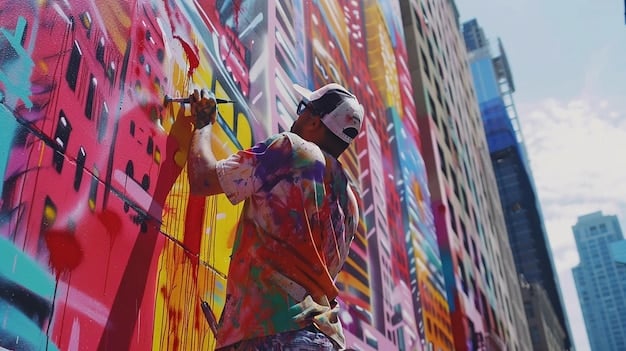
In 2025, ethical considerations for graffiti artists in the US primarily revolve around respecting property rights, engaging with communities, ensuring public safety, and navigating the complex legal boundaries between vandalism and recognized art forms, all while striving for social commentary and artistic expression.
As the vibrant world of street art continues to evolve, the question of What are the Ethical Considerations for Graffiti Artists in the US in 2025? becomes increasingly pertinent. This inquiry delves deep into the often-controversial intersection of artistic freedom, property rights, community engagement, and evolving legal frameworks.
Defining the Canvas: Public, Private, and Permission
The fundamental ethical challenge for graffiti artists often begins with the canvas itself. Unlike traditional art forms practiced in studios or galleries, graffiti inherently involves interaction with surfaces in the public or private domain. This often puts artists in direct conflict with property owners and municipal regulations, sparking debates about ownership, permission, and the very definition of art in public spaces.
In 2025, the lines distinguishing legal from illegal graffiti remain largely unchanged, contingent on consent. However, the discourse around these boundaries is shifting. Cities are increasingly exploring designated legal walls and community art programs as a means to harness the expressive power of graffiti without contributing to property damage. This creates opportunities for artists to engage ethically by seeking official avenues for their work.
The Spectrum of Legality and Illegality
- Permission-based Murals: Artists secure explicit consent from property owners or local authorities, often through formal agreements or community initiatives. These works are generally celebrated as public art.
- Commissioned Art: Businesses or individuals hire artists to create specific street art, integrating it into their branding or decor. This is a clear commercial transaction, legally and ethically sound.
- Unsanctioned Graffiti: Any mark made on public or private property without the owner’s permission, regardless of artistic merit, is legally considered vandalism in the US.
The ethical dilemma arises when an artist believes their message or aesthetic value outweighs the lack of permission. While some argue that unsanctioned graffiti challenges societal norms or draws attention to neglected spaces, this perspective directly clashes with the rights of property owners to control their assets. Ethical considerations demand a constant reflection on the impact of one’s art on others, beyond the immediate artistic impulse.
Navigating this spectrum requires artists to consider the broader implications of their actions. Is the desire for public display so urgent that it justifies potential legal repercussions, financial penalties for cleanup, or the devaluation of someone’s property? These questions are at the heart of ethical graffiti practice, pushing artists to weigh their creative ambitions against community standards and legal obligations, thereby fostering a more responsible approach to urban art.
Navigating Community Impact: Gentrification and Representation
Graffiti, while a powerful form of expression, does not exist in a vacuum. Its presence in urban landscapes can have profound effects on the communities it inhabits, stirring complex ethical questions particularly around issues of gentrification, community identity, and accurate representation. In 2025, as cities continue to evolve, graffiti artists are increasingly challenged to consider their role within these dynamics.
When vibrant, unauthorized street art appears in working-class neighborhoods, it can sometimes be perceived as a precursor to gentrification. Art, often seen as a sign of revitalization, can inadvertently attract developers and wealthier residents, leading to rising rents and displacement of long-term inhabitants. Ethical artists must engage critically with this possibility, seeking to understand the socio-economic context of their chosen canvases.
Ethical Engagement with Local Communities
- Community-Led Projects: Artists collaborate directly with residents, community leaders, and local organizations to create art that reflects the community’s values, concerns, and aspirations.
- Avoiding Stereotypes: When depicting people or cultural elements, artists should strive for authentic representation, avoiding sensationalism or perpetuating harmful stereotypes that misrepresent a community.
- Addressing Local Concerns: Art can be a powerful tool for social commentary. Ethical artists use their platforms to highlight local issues, advocate for justice, or celebrate community resilience in a way that resonates with residents.
The conversation shifts from simply painting a wall to understanding the narrative that wall inherently tells, and the people who walk past it daily. Ethical graffiti artists in 2025 are encouraged to move beyond individual artistic expression toward a form of public art that is deeply embedded in, and respectful of, its immediate environment. This involves listening to residents, participating in community dialogues, and ensuring that their art contributes positively to the lives of those it touches, rather than imposing external aesthetics or facilitating unintended consequences such as displacement.
Furthermore, the issue of representation is crucial. When artists from outside a community create art within it, there is an ethical imperative to ensure that the art genuinely reflects the community’s identity, rather than an outsider’s romanticized or stereotypical view. This could involve depicting historical figures, local heroes, or daily scenes that are meaningful to residents, fostering a sense of ownership and pride, and thus embedding the art truly within the community’s fabric.
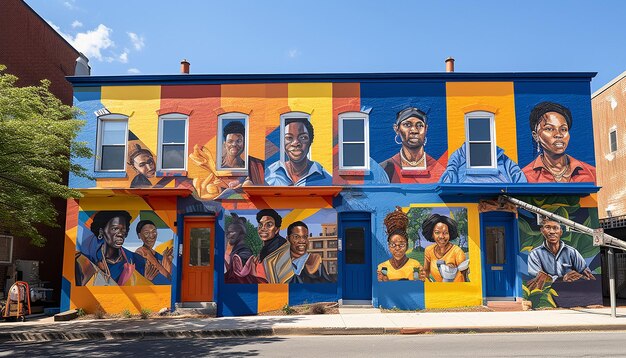
Public Safety and Environmental Impact: Beyond the Canvas
While the focus often remains on the legality and artistic merit of graffiti, ethical considerations for artists in 2025 extend to vital aspects of public safety and environmental responsibility. The materials used, the locations chosen, and the manner in which art is created can all have tangible impacts on human health and the surrounding ecosystem.
Aerosol paints, commonly used in graffiti, contain volatile organic compounds (VOCs) and other chemicals that can be harmful when inhaled or released into the environment. Ethical artists are increasingly aware of these health risks, not just to themselves but to bystanders and the broader community. This awareness is driving a shift towards safer practices and more environmentally friendly materials where possible.
Mitigating Risks and Promoting Sustainability
- Material Choices: Researching and opting for low-VOC paints, water-based alternatives, or less toxic solvents significantly reduces the environmental footprint and health risks associated with graffiti art.
- Safe Practices: Wearing appropriate personal protective equipment (PPE) such as respirators, gloves, and protective eyewear is crucial for artists working with aerosols, signaling a commitment to personal and public safety.
- Location Awareness: Avoiding painting on surfaces that could compromise structural integrity, create slip hazards, or obstruct essential signage (e.g., traffic signs, fire exits) is a fundamental ethical consideration for public well-being.
Beyond the immediate act of creation, the long-term impact of graffiti also warrants ethical consideration. How does the art degrade over time? Does it flake into the environment? Could its removal process be more harmful than its creation? These questions push artists to think holistically about the lifecycle of their work.
In addition, choosing appropriate locations for art can prevent hazards. Painting on active construction sites, unstable structures, or in dense high-traffic areas, without proper safety measures, demonstrates a disregard for public safety. Ethical artists prioritize locations that minimize risk to themselves and others, considering factors such as ventilation, foot traffic, and potential for accidental harm.
The increasing availability of artist-grade, eco-conscious materials and growing public discourse around sustainability means that excuses for harmful practices are diminishing. Ethical graffiti in 2025 implies a conscious effort to minimize harm, promote health, and actively contribute to cleaner, safer urban environments, integrating environmental stewardship into the very fabric of artistic practice.
Authorship, Appropriation, and Collaboration: Sharing the Space
As graffiti continues its journey from rebellious subculture to recognized art form, ethical considerations surrounding authorship, appropriation, and collaboration are gaining prominence. The anonymity often associated with graffiti can blur lines of credit, while the nature of public art invites interactions (both positive and negative) that challenge traditional notions of individual ownership.
In the ephemeral world of street art, credit for original work can be difficult to maintain, leading to ethical dilemmas when one artist’s style or specific piece is copied or built upon without attribution. While “biting” (copying another’s style) has historically been a contentious issue within graffiti culture, the broader art world’s emphasis on intellectual property and originality brings these ethical questions to the forefront for 2025.
Respecting Creative Ownership and Fostering Partnerships
- Attribution: When drawing inspiration from or incorporating elements of another artist’s work, ethical practice necessitates clear attribution, particularly in a professional or commissioned context.
- Originality vs. Influence: Understanding the distinction between being influenced by another artist (a natural part of creative development) and outright appropriation (using another’s distinct ideas or imagery without transformation) is crucial.
- Collaborative Etiquette: In joint projects, clear communication, mutual respect, and shared decision-making ensure that all contributing artists receive fair credit and their visions are adequately represented.
The public nature of graffiti also opens the door to ethical questions around its interaction with existing art or urban elements. Is it ethical to paint over another artist’s completed work, especially if it was sanctioned or cherished by the community? These decisions require a nuanced understanding of context, existing agreements, and shared artistic spaces.
Collaboration, particularly in sanctioned murals, presents its own set of ethical guidelines. Ensuring that all artists involved have a voice, that creative disputes are resolved respectfully, and that credit is distributed fairly are paramount. This involves transparent discussions about stylistic choices, thematic elements, and the overall vision for the collaborative piece, acknowledging individual contributions to the collective outcome.
Ultimately, ethical practice in 2025 encourages a culture of respect within the graffiti community and with the broader art world. It promotes integrity in creation, discourages unacknowledged appropriation, and champions collaborative efforts that uplift all participants, moving beyond individual egos to foster a thriving, respectful artistic environment.
The Evolution of “Vandalism” and the Law: A Shifting Perspective
The legal status of graffiti in the US has historically been straightforward: unauthorized markings are considered vandalism, a crime. However, the cultural perception and legal treatment of graffiti art are showing subtle shifts in 2025, driven by increasing public appreciation for street art, urban revitalization efforts, and the professionalization of many former “writers.”
While the core laws against property defacement remain robust, some jurisdictions are exploring nuanced approaches. This doesn’t mean a decriminalization of all unsanctioned graffiti, but rather an increased focus on distinguishing between malicious damage and genuine artistic expression, especially in cases where artists are willing to participate in restorative justice or community programs.
Navigating Legal Frameworks and Advocacy
- Understanding Local Ordinances: Artists should be aware of specific local laws regarding graffiti, including penalties, designated legal walls, and potential funding for public art initiatives.
- Advocacy for Art: Ethically, artists can engage in advocacy efforts to promote legal avenues for street art, supporting policies that differentiate between vandalism and sanctioned public art.
- Restorative Justice: In instances where unsanctioned art causes damage, ethical artists may consider offering to clean up, contribute to community projects, or participate in programs that address the harm caused, demonstrating accountability.
The rise of “mural festivals” and city-sponsored street art programs across the US exemplifies this changing perception. These initiatives actively invite graffiti artists to create large-scale works, transforming urban spaces and offering artists legitimate platforms for their talent. Ethical artists capitalize on these opportunities, thus moving their practice into a sanctioned, often celebrated, realm.
For those who continue to engage in unsanctioned work, the ethical dilemma remains sharp: Is the artistic statement worth the potential legal consequences and the financial burden placed on property owners or taxpayers for cleanup? This personal ethical calculus requires careful consideration of individual impact versus broader societal norms and laws. Engaging with public arts commissions and community groups is an ethical path forward, allowing artists to create without fear of legal repercussions and to contribute positively to urban aesthetics.
The legal landscape in 2025 is not uniform across the US; it varies significantly by city and state. Ethical artists are those who not only create compelling work but also understand and engage with the legal frameworks governing their practice, whether through compliance with existing laws or through advocating for more progressive policies that support urban art.
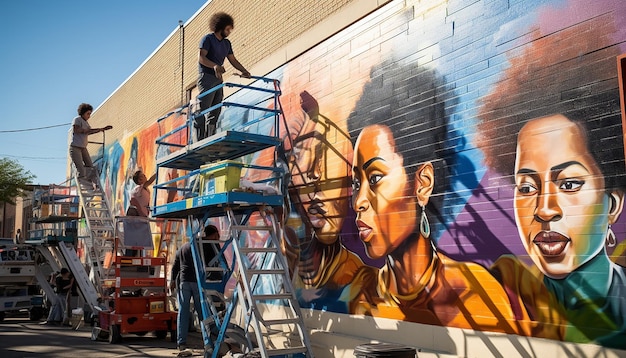
Authenticity, Message, and Commercialization: The Soul of the Art
Beyond the legal and social considerations, ethical issues for graffiti artists in 2025 also touch upon the very essence of their art: its authenticity, the integrity of its message, and its relationship with commercial forces. Graffiti traditionally emerged as a grassroots, often rebellious, form of expression. As it gains mainstream acceptance and commercial value, artists face ethical choices about maintaining their artistic integrity.
The tension between artistic purity and commercial success is not new, but for graffiti, it is particularly acute. The moment a street artist’s work is commodified—whether through gallery sales, brand collaborations, or merchandise—questions arise about whether the art loses its edge, its original intent, or its connection to the streets.
Preserving Integrity Amidst Opportunity
- Maintaining Original Vision: When approached for commercial projects, artists face an ethical choice to ensure the collaboration aligns with their original artistic vision and societal commentary, avoiding tokenism or dilution of their message.
- Avoiding Greenwashing/Artwashing: Being aware of how their art is used by corporations or developers to project a positive image without genuine community investment (often called ‘artwashing’ or ‘greenwashing’) is an ethical responsibility.
- Social Commentary Over Profit: Prioritizing the impact of their message and its contribution to dialogue over immediate financial gain is an ethical stance for many artists, especially those rooted in social justice.
The commodification of graffiti also brings up ethical questions about who benefits from the art. If an artist’s style becomes globally recognized and highly valuable, but originated in marginalized communities, is there an ethical obligation to give back, or to ensure that the community that incubated the art also benefits from its success?
Authenticity in graffiti often relates to its raw, unpolished nature and its direct engagement with social or political themes. When art is created specifically for commercial purposes, some argue that it loses this authentic connection. Ethical artists strive to find a balance, allowing for professional growth and financial viability without compromising the core values and messages embedded in their work.
Ultimately, the ethical consideration of authenticity is a deeply personal one for each artist in 2025. It involves constant self-reflection: What is the true purpose of my art? Who am I creating it for? And how can I ensure that external pressures do not distort its message or undermine its origins? This internal compass guides artists through the complex landscape of fame, money, and artistic legacy.
The Dilemma of Erasure and Preservation: A Timeless Question
The inherent impermanence of graffiti art presents a unique ethical dilemma: how do we balance the right to property maintenance and remediation with the desire to preserve significant artistic or cultural works? In 2025, this isn’t just a matter for city planners, but an ethical consideration that graffiti artists themselves often grapple with when their work, or the work of others, disappears.
Unsanctioned graffiti is, by its very nature, temporary. Property owners have a legal and often aesthetic right to remove it. However, when a piece of unsanctioned graffiti becomes iconic, deeply embedding itself within local culture, or is recognized for its artistic merit, its erasure can feel like a loss to the community and the artistic world.
Ethical Approaches to Longevity and Legacy
- Documenting Ephemeral Work: Artists often ethically choose to thoroughly document their work through photography and videography, ensuring its existence beyond its physical presence on a wall.
- Contributing to Community Archives: Participating in efforts to archive street art, whether digital or physical, helps preserve the historical and artistic record of ephemeral pieces.
- Seeking Designated Spaces: Artists who wish their work to endure can ethically pursue opportunities on legal walls, commissioned murals, or public art installations designed for longevity.
The ethical challenge also extends to artists who might paint over existing art. While “going over” another artist’s work is a long-standing (and often aggressive) tradition within the subculture, ethical considerations arise when the covered piece holds significant community value or artistic recognition. This can be particularly contentious in legal-wall settings where space is shared.
Some communities grapple with designating certain unsanctioned pieces as protected, despite their illegal origin, due to their profound cultural impact. This creates a fascinating ethical paradox for city authorities and art conservators. For artists, this raises the question of whether their work, once created, has a “right” to exist indefinitely, even if it violates property rights.
In 2025, the conversation around graffiti’s preservation is less about halting removal and more about strategic documentation and the creation of durable, sanctioned alternatives. Ethical artists support and engage with initiatives that responsibly document their art, acknowledging its transient nature while contributing to its enduring legacy through other means, thereby finding a balance between artistic expression and civic responsibility.
| Key Ethical Area | Brief Description |
|---|---|
| ✨ Property Rights | Securing explicit permission for artwork to avoid legal repercussions and respect ownership. |
| 🤝 Community Impact | Considering effects on local residents, avoiding gentrification, and ensuring authentic representation. |
| 🌿 Safety & Environment | Using non-toxic materials, ensuring public safety, and minimizing ecological footprint. |
| 🎨 Authenticity & Message | Maintaining artistic integrity and message against commercial pressures and potential appropriation. |
Frequently Asked Questions
▼
No, not all graffiti is illegal. While unsanctioned graffiti remains vandalism, a significant portion of street art is commissioned or created on designated legal walls with permission from property owners or municipalities. This distinction is crucial in understanding the complex landscape of urban art and its legal boundaries.
▼
Ethical graffiti artists prioritize gaining permission for their work, consider the impact on local communities, use safer materials to minimize environmental harm, and engage in responsible artistic practices. This includes proper attribution, avoiding appropriation, and contributing positively to urban aesthetics and social dialogue.
▼
Artwashing occurs when companies or developers use art, including graffiti or murals, to appear progressive or community-minded without genuine commitment to social or ethical practices. It’s an ethical concern because it can co-opt artistic expression to mask negative impacts like gentrification or exploitation, making art complicit in deceptive marketing.
▼
Yes, significant environmental considerations exist. Traditional aerosol paints contain VOCs and other chemicals that can be harmful. Ethical artists are increasingly opting for low-VOC paints, water-based alternatives, and proper disposal methods to minimize their ecological footprint and protect public health, demonstrating environmental responsibility.
▼
Professionalization brings new ethical challenges, such as balancing artistic authenticity with commercial opportunities. Artists must carefully navigate commissioned work to ensure their original message isn’t diluted or exploited. It also elevates discussions around intellectual property and fair compensation within a traditionally unsanctioned art form.
Conclusion
The ethical landscape for graffiti artists in the US in 2025 is more nuanced and complex than ever. It demands a thoughtful approach that balances artistic freedom with a deep respect for property rights, community well-being, public safety, and environmental stewardship. As street art continues to gain mainstream recognition, artists face increasing pressure to operate within evolving legal frameworks while maintaining the authenticity and integrity of their message. The most impactful graffiti will likely be that which not only captivates visually but also reflects a profound ethical consciousness, contributing positively to urban culture and dialogue.
